TANTUI AT UK SUMMER CAMP
OVERVIEW
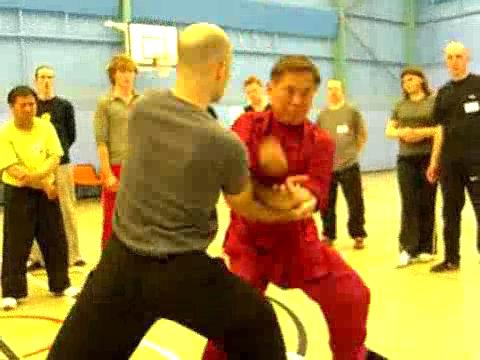
Combat Application of Shaolin Tantui
1 The Secret of Internal Force Training
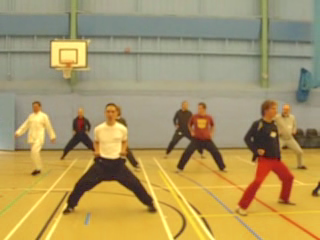
What is the secret of the internal force masters? It is zhan zhuang, or stance training. Stance training is the one most important category of exercises to develop internal force. It also develops mental clarity and spiritual joys. The main Shaolin stances are shown here, namely Horse-Riding, Bow-Arrow, False-Leg, Unicorn, Triangle, Single-Leg and Goat Stance. There are only two steps in stance training. Firstly, make sure that the posture is correct. Then follow the three golden rules, namely relax, relax and relax.
Click here to enter.
2 Experiencing the Effects of Deviated Practice
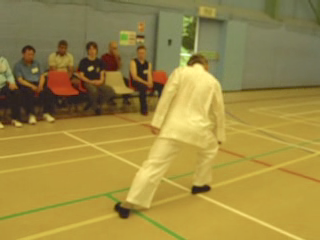
The way we perform some of our stances is quite different from that in other schools. For example, our Horse-Riding Stance maintain a triangle or pyramid shape. This enables cosmic chi to flow to our legs and root us to the ground, as well as to be accumulated at the dan tian. Our Bow-Arrow Stance is formed with our feet in line, and our toes turned inward at about 45 degrees. In the Goat Stance we turn both feet inward at angle between 5 to 10 degrees. Course participants try out the different postures of the various stances, and find from direct experience that the deviated positions bring harm.
Click here to enter.
3 Basic Footwork Training
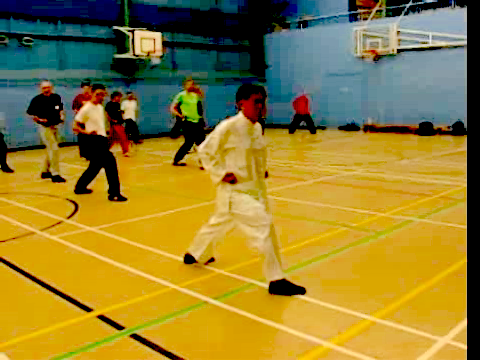
One often hear people saying that "ma-bu" is very important, but not many realize that "ma-bu" refers not just to the Horse-Riding Stance or stances in general. There are actually two concepts in the term, namely "ma" and "bu". "Ma" refers to stances, and "bu" to footwork. Hence, it is not sufficient that we train our stances, but also our footwork, thus manifesting the yin-yang harmony of the term. In other words, we should not only be solid, which our stance training will bring, but also be agile, which comes from good footwork.
Click here to enter.
4 From Correct Movement to Speed and Elegance

We often hear kungfu practitioners saying that the basics are very important, but they often do not realize what the basics mean, thinking mistakenly that the basics refer to kungfu patterns. In our school, the basics go beyond the kungfu patterns. They refer to stances and footwork, body-movements, hand forms, elegance and fluidity, breath control and energy flow and mental calmness and clarity. In other words, they refer to the six harmonies of all kungfu movements. Here we focus on footwork. We learn how to move with speed and elegance, as well as to minimize setbacks and maximize advantages.
Click here to enter.
5 Various Ways of Turning
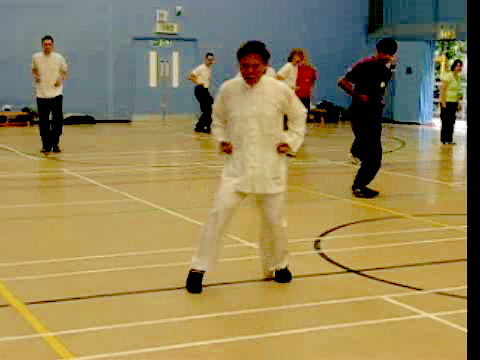
You may be surprised that to enhance combat efficiency, many considerations are involved when you turn from one direction to another. The most obvious factor is direction. There are eight major directions which correspond to the compass points, namely north, south, east, west, north-east, north-west, south-east and south-west. Another consideration is leg-mode, which can be left-to-left, left-to-right, right-to-left or right-to-right. The point of reference can be front-point reference, mid-point reference and end-point reference. The body-movement may be clockwise and anti-clockwise, and the leg-approach may be yin, yang and straight.
Click here to enter.
6 Adding Hand Forms to Stances to Form Patterns

In our school leg stretching is performed not as physical exercise but as chi kung. Hence it contributes not only to our flexibility but also to our force and speed. When we can perform stances and footwork with flexibility, force and speed, learning new patterns is a matter of adding appropriate hand forms. The class has a gala time moving about with various patterns in different stances.
Click here to enter.
7 The Mechanics of Fa-Jing or Exploding Force
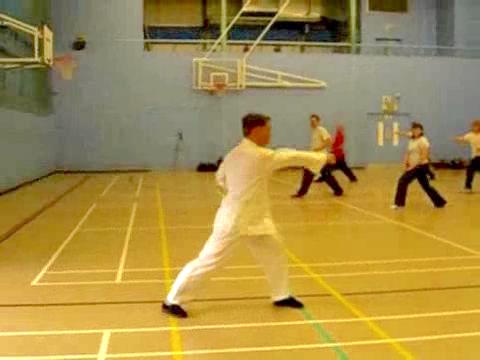
"Fa-jing", or exploding force, is often spoken of but little understood. Besides internal force, the mechanics to explode the force is also important. "Black Tiger Steals Heart" is an excellent pattern to practice "fa-jing". Once you have attained the skill of exploding force, you can apply the skill in any patterns. The movement starts from the back leg, is controlled by the rotation of the waist which spirals out the internal force from the dan tian, and the force is exploded in the fist. This co-ordination of the legs, body and hands constitutes the three external harmonies. The movement should be elegant, the chi flow should be smooth and the mind focused. This constitutes the three internal harmonies.
Click here to enter.
8 Bo-Fa and Shen-Fa or Footwork and Body-Movement

A common mistake many martial artists make is focusing only on their hand forms but neglecting their footwork and body-movement. Footwork is not just how to move in correct stances. It includes, among other aspects, the appropriate positioning of the feet and the rotation of the knees. A crucial aspect of body-movement is the rotation of the waist. This is especially emphasized in Taijiquan, but is also important in Shaolin Kungfu. Amongst other benefits, rotating the waist minimize an opponent's force and maximize your own.
Click here to enter.
9 The Three Harmonies of Legs, Body and Hands
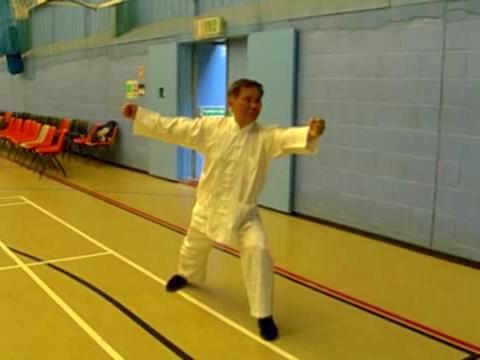
Many of our students are amazed that they could learn kungfu sets from us very quickly. A main reason is that we place great emphasis on the basics. Once we perform the basics well, we can learn any patterns quickly. The basics of the patterns are the three harmonies, a term sometimes mentioned but seldom understood. Kungfu classics often explain the three harmonies as the legs harmonize with the body, the body harmonizes with the hands, and the hands harmonize with the legs. As usually the case in the kungfu classics, the explanation was not meant for public consumption but as a reminder for practitioners who had gone through the the three harmonies themselves
Click here to enter.
10 Tantui Sequence 1 -- Thrust Punch
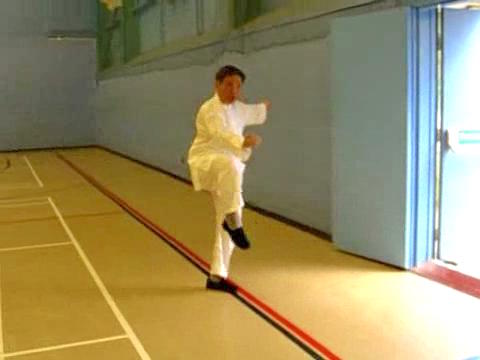
The first sequence of Tantui, called "Thrust Punch", is simple to perform but profound in application. Would you believe that you can use just this sequence to handle any forms of attacks? Indeed, if you specialize in just this one sequence, you can become quite a formidable fighter. The various patterns in the sequence should be performed as if they were one long, continuous pattern. The performance is guided by the three external harmonies of feet, body and hands, and the three internal harmonies of essence, energy and mind.
Click here to enter.
11 The Three Fs -- Form, Force and Flow
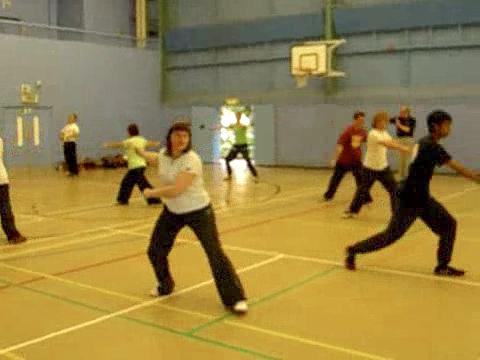
A good strategy to learn and practice a set is the three Fs - Form, Force and Flow. First, get the form correct, paying attention to the three external harmonies of legs, body and hands. Next, explode force wherever is needed. The force is internal, not mechanical. Then link all the patterns together in one continuous flow where there is no beginning and no ending. The flow should be smooth, and this will lead to speed. If you follow the three Fs, your kungfu movements will be beautiful, fast and forceful, yet you will not be tired nor panting for breath.
Click here to enter.
12 Every Kungfu Session is a Training of Energy and Mind
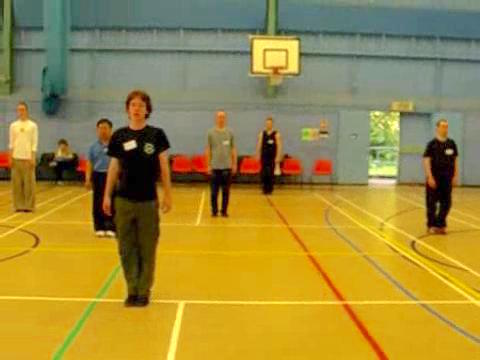
In Shaolin Wahnam, every kungfu movement is a training of mind and energy. Hence our students practice kungfu, chi kung and meditation at the same time. This was how great Shaolin Kungfu (as well as Taijiquan) was practiced in the past. When our students make a physical movement, it is done not by muscular tension but by chi. Hence, at the end of a kungfu performance, they can go into vigorous chi flow. They conclude the chi flow in Zen or meditation.
Click here to enter.
13 Simple in Appearance but Profound in Application
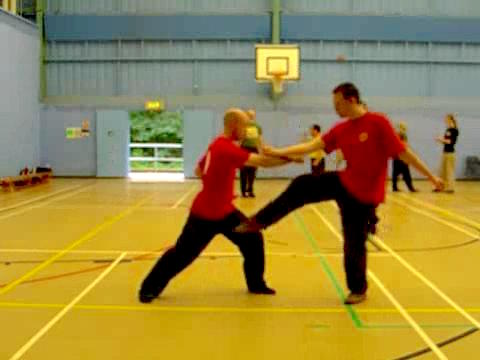
Tantui is very popularly practiced today, but unfortunately the great majority of Tantui practitioners only perform the solo forms without understanding their combat application. They may be very surprised that all the Tantui patterns are very useful for fighting. Indeed, if one is fluent in just Tantui Sequence 1, which is called "Thrust Punch", he can be quite a formidable fighter. Imagine how combat efficient a Tantui master will be when he is fluent in all the twelve Tantui sequences. The Tantui patterns may look simple, but they can be quite profound. For example, the pattern "Roll Elbow", known in Southern Shaolin as "Crow Flaps Wings", has many other combat functions besides being an effective elbow strike. It can be used to release an opponent's grip or to fell an opponent.
Click here to enter.
14 If you Use a lot of Kicks, you should also Know their Counters
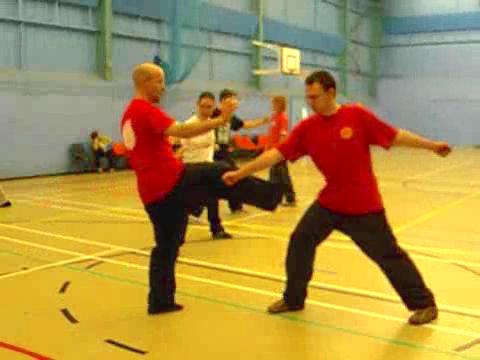
Shaolin Tantui is famous for its kicks. Some martial artists may be surprised as they may not see many obvious kicking techniques in a Tantui demonstration as they would normally see in martial arts associated with kicks like Taekwondo and Muay Thai. The main reason is that the kicks are purposely made inconspicuous. Another difference between Tantui and other kicking arts is that there are also many effective counters against kicks, although many martial artists, including many Tantui practitioners themselves, may be unaware of it. It is logical in kungfu philosophy. If you use a lot of kicks yourself, you should also know a lot of counters against kicks. Being able to neutralize your own attacks will not only prevent you from being defeated by your own techniques, but also enhance the understanding and application of your attacks.
Click here to enter.
15 It is Necessary to have an Element of Threat in Combat
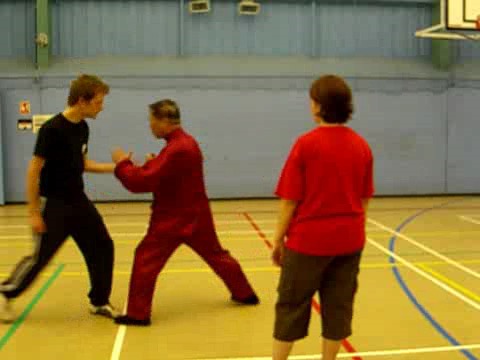
A major weakness in kungfu training is that kungfu practitioners often lack an element of threat in their combat. This lack of an element of threat is also a major reason why many kungfu practitioners are not combat efficient. They are unaccustomed to both attacking fiercely and defending against fierce attacks. Thus, if you wish to be combat efficient, you have to overcome this weakness. Adding an element of threat does not necessarily mean that we need to be aggressive and injure our sparring partners. Our attacks and counters can be threatening, but we can still be in good control so as not to hurt our sparring partners or even real opponents unless we want to.
Click here to enter.
16 Counters against Formidable Muay Thai Knee Jabs
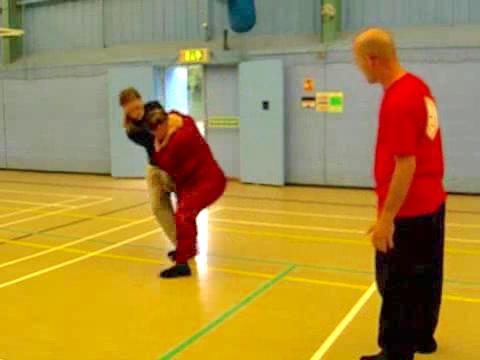
Many martial artists are weary of meeting Muay Thai opponents. Muay Thai knee jabs, for example, are ferocious and formidable. But like any other attacks, they can be countered easily if you know how. As Muay Thai is a sport, a Muay Thai fighter would merely hold your neck, instead of gripping it, when simultaneously kicking you with knee jabs. But in a real fight, an opponent may also grip your neck, thus making the attack even more formidable.
Click here to enter.
17 Against Shoots, Throws, and Felling Opponents

Although the shoot is an unwise attacking technique in a real fight unprotected by safety rules, today many martial artists use it. Rolling Elbow and Throwing Fist, both found in Tantui Sequence 1, are effective counters against the shoot. They are also effective against an opponent attempting to fell you, or on the other hand for felling an opponent. Can you figure out how this is possible before viewing the video clips?
Click here to enter.
18 Learning Tantui Sequences 1, 2 and 3
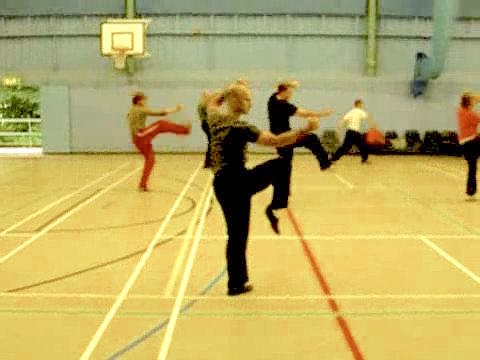
Today many kungfu practitioners only perform kungfu patterns without their combat application. This is one of the main reasons why kungfu - any style of kungfu -- has been so badly debased. Do you know the combat applications of the patterns in these sequences?
Click here to enter.
19 Learning Tantui Sequences 4, 5 and 6

Sequence 4 is quite complex, and needs much skill to apply its combat applications. Sequence 5 is simple, but its combat application can be very profound. The Double Spread in Sequence 6 can be used in many different situations, but many practitioners use it wrongly as a double hand attack.
Click here to enter.
20 Learning Tantui Sequences 7, 8 and 9
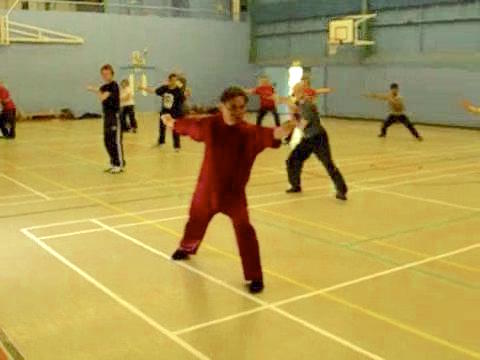
Sequence 7 is very useful against Boxing. Sequence 8 contains a tactic to trick an opponent. Would you believe that when you are proficient with Sequence 9, you may counter any locks against you?
Click here to enter.
21 Learning Tantui Sequences 10, 11 and 12
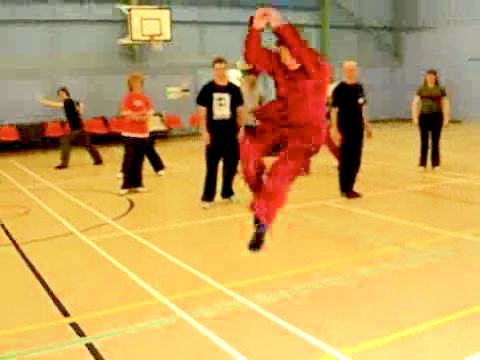
Sequence 10 is a formidable pressing attack. Sequence 11 incorporates a few felling techniques. Can you tell what the kicks are by watching the sequence? Can you also tell what the combat applications of Sequence 12 are?
Click here to enter.
22 Applications of Single Spread and Breaking Lock

"Single Spread" and "Breaking Lock" are different techniques though they appear similar because "Breaking Lock" often includes the spreading arm technique. "Single Spread" is excellent for breaking opponent's arms, whereas "Breaking Lock", as its name implies, is meant for breaking opponent's locks.
Click here to enter.
23 Breaking Almost any Lock with the Breaking Lock Technique
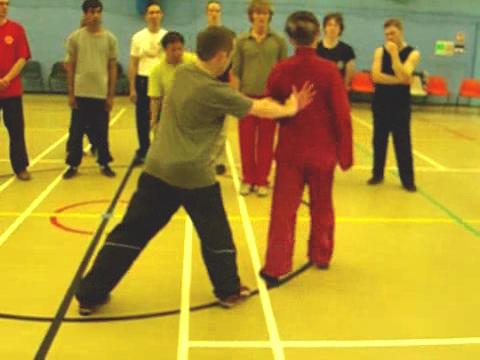
The technique of "Breaking Lock" looks simple, but its applications can be very profound. Would you believe that you may apply it to break almost any lock? However, breaking the lock executed with the pattern "Fierce Tiger Returns to Plain", which is similar to the Full Nelson Lock, requires some modification of the "Breaking Lock" technique.
Click here to enter.
24 The Richness of Tantui Combat Applications
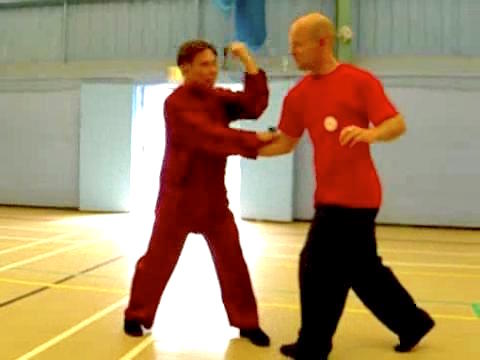
"Tantui" looks simple but it contains all the four categories of attack - striking, kicking, felling and chin-na - and their defences. You can find examples of all these attacks in this short series.
This video series also depicts some effective counters against Boxers and Kick-Boxers. It may sound presumptuous but if you can skillfully apply just the combat techniques shown here, you can counter Boxers and Kick-Boxers quite comfortably.
Click here to enter.
25 Second Brother and White Horse
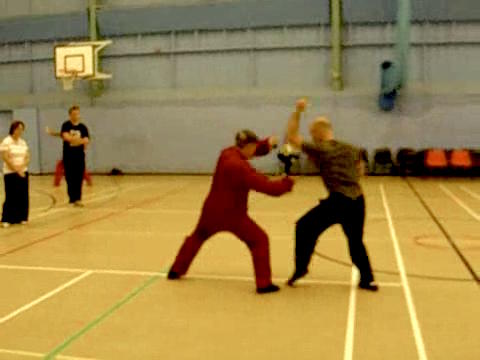
It is a common mis-conception amongst some kungfu practitioners that a particular attack has to be countered with a particular technique. The task of kungfu practitioners, therefore, is to search for counters. An effective counter against "Second Brother Offers Wine" is "White Horse Returns Head". It may be of interest to many kungfu practitioners that the reverse is also true, i.e. "Second Brother Offers Wine" is also an effective counter against "White Horse Returns Head"! "Second Brother Offers Wine" is a "throwing punch", whereas "White Horse Returns Head" is a "lift-strike". Both patterns are found in the Tantui Set.
Click here to enter.
26 An Effective Sequence against Boxers

There are twelve Tantui Combat Sequences, one each for each solo Tantui Sequence. Each sequence has its special features. Tantui Combat Sequence 1 is an example of profundity in simplicity. Amongst its many combat functions, there are some effective techniques against Boxers. As most martial artists today fight like Boxers irrespective of the styles they practice, it is a very useful sequence to practice if you wish to be combat efficient.
Click here to enter.
27 Three Harmonies in Tantui Combat Sequence One
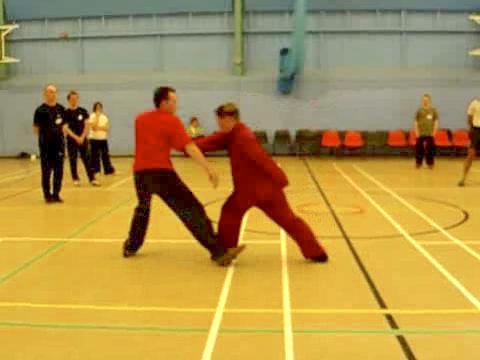
A kungfu technique can be analyzed into three components, namely feet, body and hands. A co-ordination amongst these three factors constitutes the three external harmonies. A technique can be effectively applied in combat only when these three components are in harmony - a fact many kungfu practitioners may be unaware of. This video series on Tantui Combat Sequence 1 provides some illuminating examples of the importance of the three external harmonies in combat.
Click here to enter.
28 White Horse Returns Head
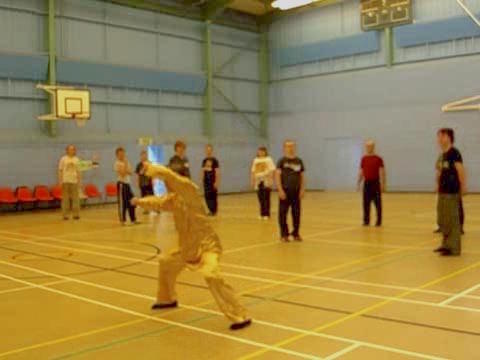
"White Horse Returns Head" can be a very effective counter against many kinds of attacks, but its successful application depends much on agile footwork and body-movement. This series shows some illuminating examples. These attacks and counters are found in Combat Sequence One.
Click here to enter.
29 Adjustments and Modifications in Varied Situtations
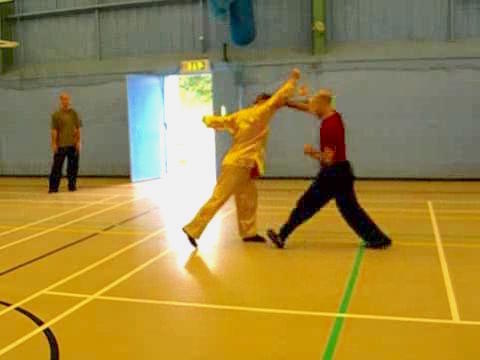
Here is how to make adjustments or modifications in some varied situations when applying "White Horse Returns Head" and "Second Brother Offers Wine", two important patterns in Combat Sequence One. Picture-perfect form is also necessary.
Click here to enter.
30 Effective Techniques against Boxers
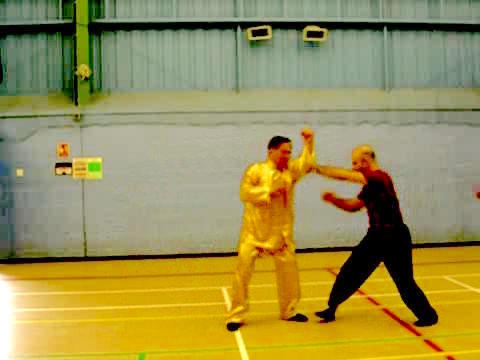
Many people are weary of fighting against Boxers because of their speed. Tantui Combat Sequence One provides some effective techniques to fight against Boxers. Covering or floating a Boxer's attacks, and correct spacing are important.
Click here to enter.
31 Combat Skills against Boxers
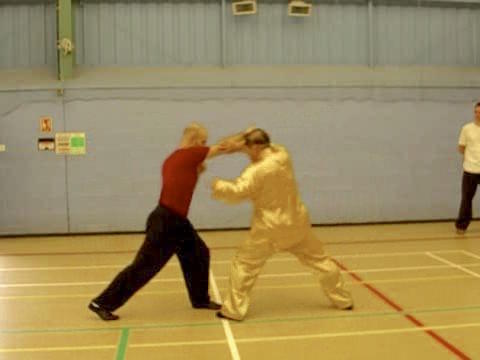
Skills are more important than techniques in combat. In other words, even if you have the right techniques to counter an opponent's attacks, if you lack the necessary skills, you will fail to defeat him. This series shows some important skills you should have when fighting against Boxers.
Click here to enter.
32 The Tactics of Covering and Chasing against Boxers
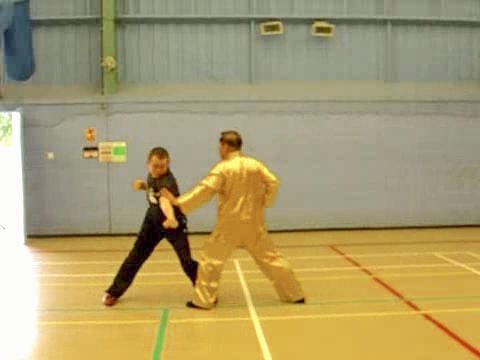
Boxers are fast and agile. Trying to fight them at their speed is becoming a victim to their game. There are many tactics in Shaolin Kungfu that are effective in overwhelming Boxers. "Covering" and "Chasing" are two such tactics.
Click here to enter.
33 The Unbelievable Effectiveness of Tantui Combat Sequence One
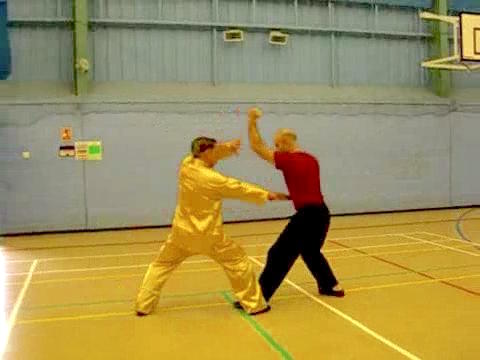
Tantui Sequence One, known as "Thrust Punch", is simple, but when applied by a skillful exponent, it can be used against any attacks! This may sound unbelievable but it is true. The video series here shows the Combat Sequence of Tantui Sequence One.
Click here to enter.
34 Old Elephant Drops Tusk in Tantui Combat Sequence Two
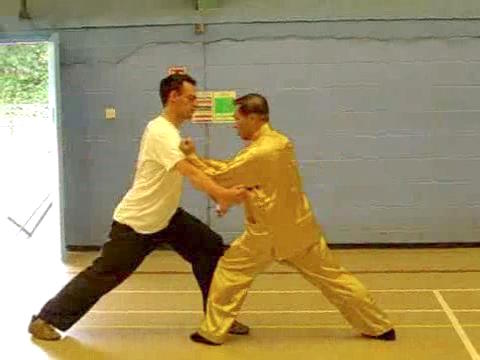
How would you defend against a powerful swinging punch, as in the pattern "Second Brother Offers Wine"? One effective counter is "White Horse Returns Head", as shown in Tantui Combat Sequence 1. Another effective counter is "Old Elephant Drops Tusk", which is shown in Tantui Combat Sequence 2 here. It often catches an opponent by surprise.
Click here to enter.
35 Rising Dragon Galloping Tiger
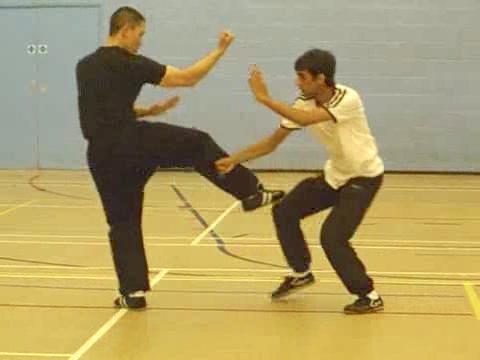
"Rising Dragon Galloping Tiger" is as effective as it is poetic. When it seems that you are caught in a difficult situation, this pattern not only provides an escape but often turns defeat into victory. Many uninitiated persons would find it difficult to defend your attack on his head and groin at the same time. This pattern is found in Combat Sequence 1 as well as Combat Sequence 2 as shown in this video series.
Click here to enter.
36 Combining Sequences in Combat Training
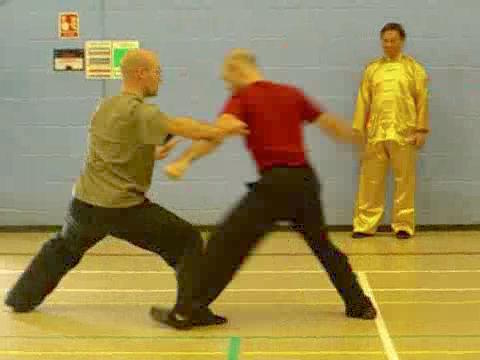
By being fluent in Combat Sequences 1 and 2 of Shaolin Tantui, you can be quite formidable in combat. In your practice, you may combine them in various ways. Combining two or more combat sequences with "addition and subtraction" is an excellent method to train free sparring.
Click here to enter.
37 Importance of Skills in Applying Combat Sequences
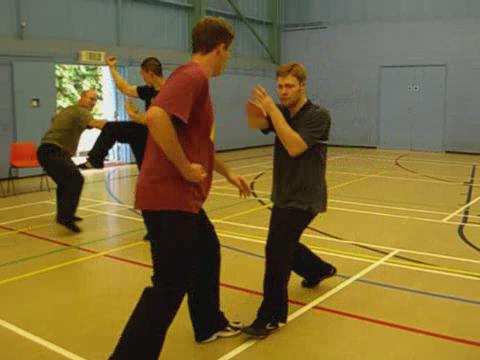
The combat effectiveness of Tantui combat sequences is due not just to their techniques but more significantly to how skillfully you apply them. Various manners to practice Combat Sequence to attain combat efficiency in its application are shown in this video series.
Click here to enter.
38 Some Effective Skills for Combat

When you can execute the combat sequences flowingly, you may focus on developing some special skills related to the sequences. You may, for example, intercept an opponent's attacks. You may close an opponent so that he cannot attack you. Or you may neutralize an opponent closing you by merely moving a step back.
Click here to enter.
39 Three Rings Around Moon in Tantui Combat Sequence Three
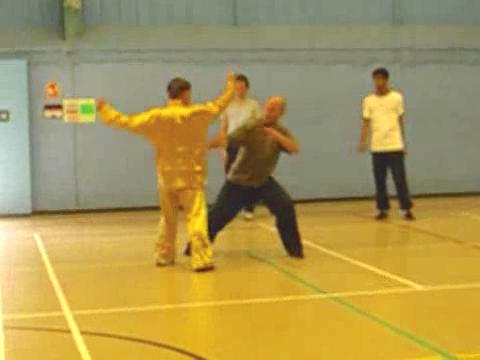
"Three Rings Around the Moon", which is found in Tantui Combat Sequence 3, is a formidable technique for both attack and defence. It is excellent against kicks. Good spacing is necessary; poor spacing may expose the exponent to risky counters. One effect counter for this formidable attack is to use "chin-na".
Click here to enter.
40 Applying Chin-Na and Countering Chin-Na
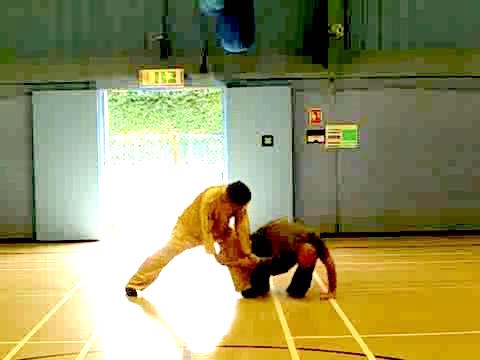
If your arms are powerful and you apply "Three Rings Around Moon" skillfully, it is like you using two iron rods to strike an unarmed opponent. Nevertheless, despite the iron rods-like attacks there are effective counters. Using "chin-na" or gripping is one example. There are, of course, also counters against the chin-na counters.
Click here to enter.
41 Solo Performance to Enhance Combat Efficiency
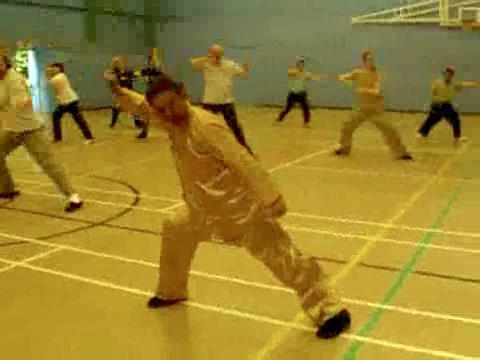
When they see a performance of solo kungfu patterns, most kungfu practitioners today do not know what the patterns are meant for. Here, the class performs some sequences of solo Tantui patterns. Do you know the meaning behind the patterns? Of course, you do. They are Tantui Combat Sequences 1, 2 and 3 performed in solo. Performing them in solo is one effective way to enhance combat efficiency. Do you know why?
Click here to enter.
42 Simple in Solo Performance, Profound in Combat Application
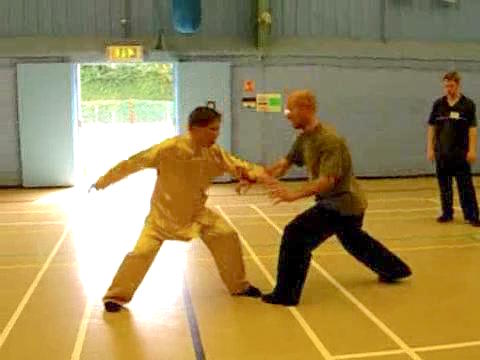
Although Tantui sequences look simple in solo performance, their combat applications are profound. Here you can see the class reviewing the first three Tantui combat sequences. Can you find the formidable iron-rod-like attacks in Sequence 3. How would you counter such attacks? And what would you do if an opponent applies such counters on you?
Click here to enter.
43 Counter against the Formidable Muay Thai Knee Jab

The Muay Thai knee jab is dread by many martial artists. Many of them do not know how to defend against it. Such an attack is of course found in kungfu. Its attacking pattern is known in Shaolin as "Jade Girl Kicks Shuttle", and as "Throw Knee at Chest" in Taijiquan. How would you counter such a formidable attack, especially when your neck and arm are being hooked?
Click here to enter.
44 Felling an Opponent without Throwing Him

In Shaolin Kungfu there are many other ways of felling an opponent apart from throwing him. One way is found in Tantui Combat Sequence 4, which often catches an opponent by surprise. How would you counter such a surprised felling attack? And how would you counter the counter? This countering and countering surely makes kungfu application very interesting.
Click here to enter.
45 Tantui Combat Sequences One, Two and Three
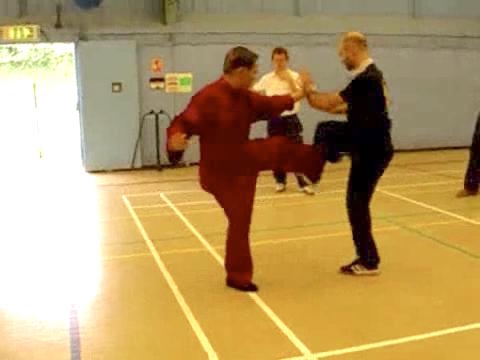
If you cannot make out the combat applications of the Tantui Combat Sequences 1, 2 and 3 when performed in solo, the videos here showing the three sequences performed in combat format will be useful. There is also an application of the nail-kick against the whirlwind kick found in Combat Sequence 3.
Click here to enter.
46 Chopping Firewood and Hook Thrust

"Chopping firewood" and "hook thrust" found in "Three Rings Around Moon" and "Green Dragon Exhibits Tail" in Tantui Combat Sequence 3 and 4 offer many techniques for both attack and defence. These techniques are quite sophisticated, and often render many opponents in a helpless situation.
Click here to enter.
47 The Technique of Double Spread in Carry Moon in Bosom

One effective way to counter an arm grip is “Double Spread”, implemented in the pattern “Carry Moon in Bosom”. Please note that the double punches of this pattern is not meant to punch an opponent at two points, as many people may mistakenly think and which will leave you dangerously exposed, but to control him with one hand and strike him with the other.
Click here to enter.
48 Combat Sequences 4, 5 and 6 in Solo Practice and Partner Combination
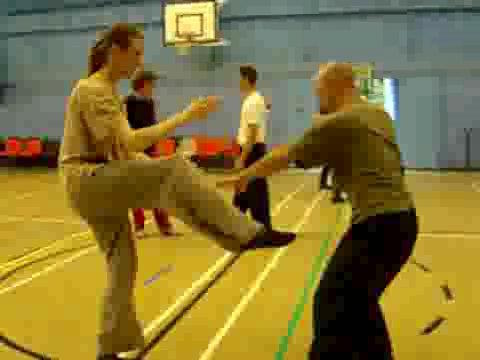
Course participants review Combat Sequences 4, 5 and 6, which are “Green Dragon Exhibits Tail”, “Crossroads Lift Strike” and “Carry Moon in Bosom”. The uninitiated may not realize the combat functions of these sequences, thinking they are merely decorative. These sequences contain some fasinating combat applications, which are respectively a sophisticated way to counter kicks, a simple way to counter elbow and knee strikes, and an effective way to counter double arm grips.
Click here to enter.
49 Sounding Bell to Handle Fast, Continuous Strikes

This is a bafflingly simple technique but with effective combat functions. After learning it here, you may wonder why you haven't thought of it before. The technique is called “Single Spread”, and it consists of using your arm like an iron rod to strike appropriate parts of your opponent, like his arms, legs, body and head. It is very effective against Boxers and those who employ fast, continuous punches. The pattern used here to implement the technique is called “Single Strike Bell Sounds”.
Click here to enter.
50 Using a Nail Kick to Counter a Whirlwind Kick
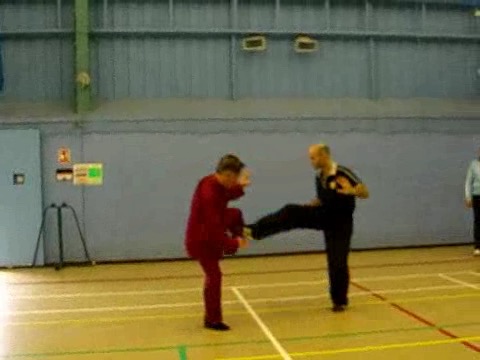
Northern Shaolin Kungfu is well known for leg techniques. Hence, although the representative technique of this Combat Sequence 7 is employing the arm to strike any attacks using the technique of “Single Spread”, this sequence also incorporates some amazing leg techniques. When an opponent attacks you with a whirlwind kick, for example, you may counter with a Nail Kick, i.e. striking his kicking knee with the tip of your shoe like a nail.
Click here to enter.
51 Cloud Hand and Horn Punch against Chin-Na and Throat Strike
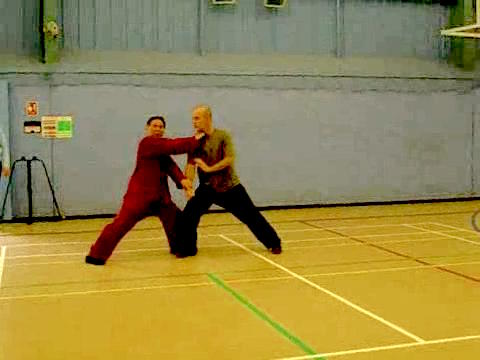
What would you do if an opponent grips your arm with one hand and simultaneously strikes your throat with his other hand? Many people would be caught by surprise and not know what to do. There are many ways to counter this. But whatever counter you may use, you must have practiced it beforehand, so that if a real situation arises, you just implement the counter without thinking and without hesitation. One effect way is to counter with a horn punch, simultaneously releasing the opponent's grip and brushing away his strike with a cloud hand,
Click here to enter.
52 A Little Jump as a Trick
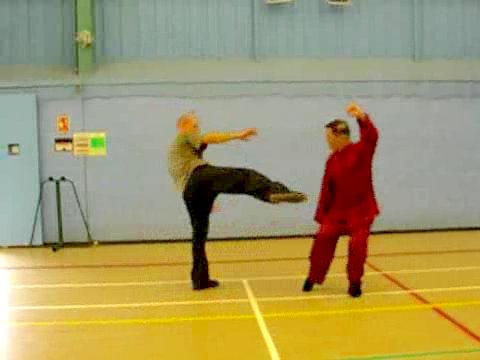
Many people are weary of sweeping kicks, or whirlwind kicks in kungfu terminology. They are fast and powerful. Blocking these kicks, as some martial artists may do, may result in the defenders' broken arms. But there are actually many counters against the powerful whirlwind kicks. One way, using a Nail Kick, has been shown in earlier clips. Here, the response is a little jump away. It is a trick to tempt the opponent to continue his attack. Hence, you must not jump too far away. It should be far enough to avoid his kick, but near enough so that he can move in easily to continue his attack. What would you do when he moves in? This will be shown in the next video series.
Click here to enter.
53 Striking Opponent Before he Realizes with Shooting Spear
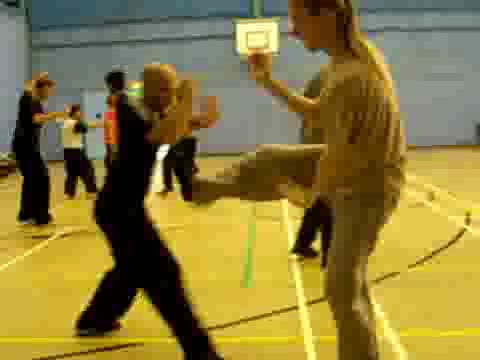
This is Combat Sequence 8. As your opponent attacks with a whirlwind kick or any other forms of attack, you jump away slightly to avoid the attack. You should be far enough to avoid the attack, but near enough for your opponent to move in easily to continue his attack. If you are too far from your opponent, he may not move in. As he moves in, you surprise him with a thrust kick, often hitting him before he realizes what has happened. Simultaneously you strike out your punch, which may deflect his hand attacks or actually strike him too. This pattern is called “Shooting Spear at Yun Pavilion”.
Click here to enter.
54 Technique to Counter Chin-Na or Gripping Attacks
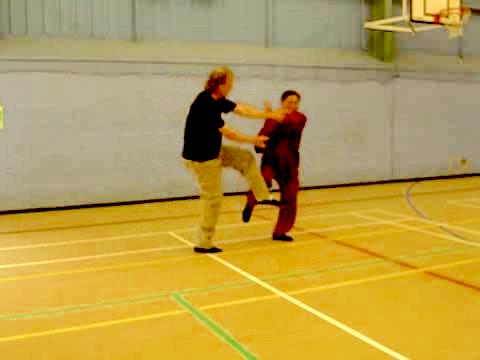
Chin-na, which is a special way of gripping, is a very sophisticated method of attack. As many martial arts do not have chin-na in their repertoire, if you can successful apply chin-na on their exponents, they would have no techniques to counter you. Amazingly, there is one technique in Tantui which can be used to counter any chin-na or gripping attacks. This technique is called “Breaking Lock” and is implemented in Combat Sequence 9 in the pattern “Second Brother Breaks Lock”.
Click here to enter.
55 Hand Technique to Counter Hand Attacks and Leg Technique to Counter Low Kicks
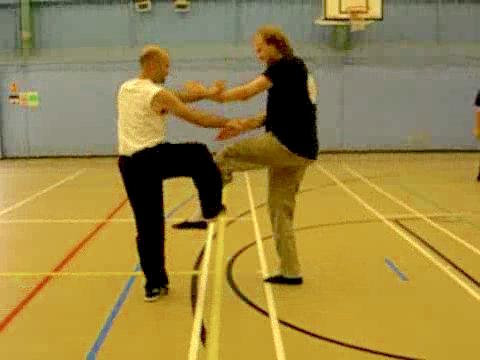
There is a kungfu saying as follows: “Southern Fists, Northern Kicks”. It means that that southern styles of kungfu are well known for their hand techniques, whereas northern styles are famous for their kicks. Tantui is the essence of northern styles, but it does not neglect hand techniques. In Combat Sequence 9 there is a hand technique that can be used to counter any hand attacks, and also a leg technique that can be used to counter any low kicks! Is this incrediable?
Click here to enter.
56 Amazing Combat Functions in Combat Sequences 7, 8 and 9
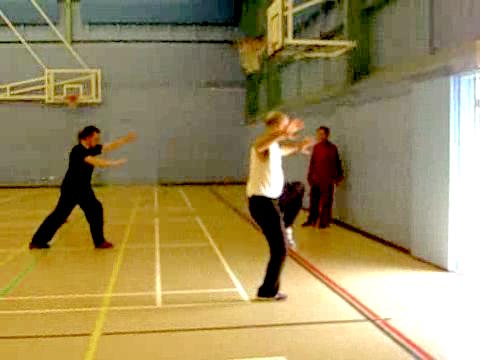
This is a review of Combat Sequences 7, 8 and 9 performed in solo. They are called “Single Strike Bell Sounds”, “Shoot Spear at Yun Pavilion” and “Second Bother Breaks Lock” respectively. Those who practice only kungfu forms without combat application may think the patterns in the sequences are merely for demonstration. They are actually very effective for combat. Amongst many other functions, Sequence 7 can be used against any fast, continuous punches, Sequence 8 incorporates a tactic to trick an opponent, and Sequence 9 can be used to break any locks!
Click here to enter.
57 Countering any Attacks and Tempting an Opponent into a Trap
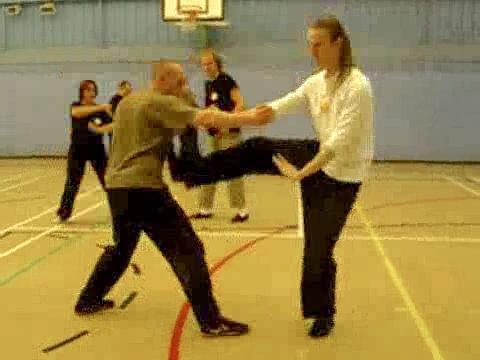
Here are some crucial points found in Combat Sequences 7 and 8. In Combat Sequence 7, a Tantui exponent may use his arm in “Single Spread” to counter any attacks! It is very effective against someone, like a Boxer, who uses quick, continuous punches. In Combat Sequence 8, some sophisticated leg techniques are explained. This sequence incorporates a tactic to tempt an opponent into a trap. Course participants then practice these two sequences.
Click here to enter.
58 Continuous Attacks in Combat Sequence 10
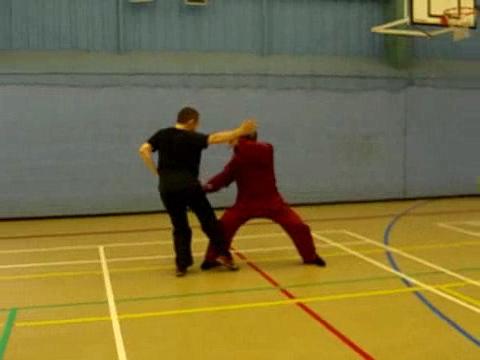
If you attack your opponent continuously in one smooth movement, you will have a better chance of defeating him than if you attack him singularly. But it is important that you cover yourself well in your attack, giving little or no opportunity for your opponent to counter attack. Tantui Combat Sequence 11 provides an excellent example of such continuous attacks.
Click here to enter.
59 Pressing Attacks with Continuous Spring-Kicks
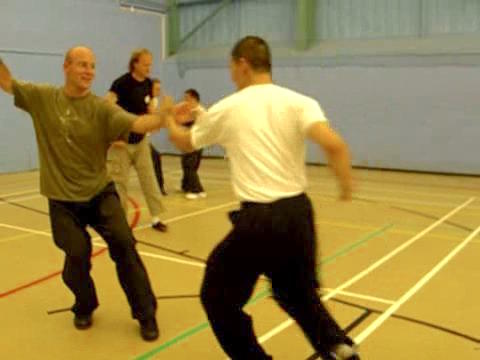
How would you counter an opponent attacking you continuouslly?. One effective way is to intercept his attack and counter attack. But a skillful exponent can neutralize the counter-attack and continue his pressing attacks. This is shown in Combat Sequence 10 where the exponent first presses in with triple attacks, and after neutralizing a counter-attack, continues to press in with continuous kicks. The combat sequence is known as “Arrow Spring”. Indicating that the pressing attacks are fast like arrows and coupled with spring-kicks.
Click here to enter.
60 Picture-Perfect Form in Planned Sequence of Pressing Attacks

If you are skillful you can overwhelm an opponent with a planned series of attacks regardless of his responses! Combat Sequence 1 is a good example. Combat Sequence 10 here is another excellent example. Picture-perfect form is required for a successful application of your planned sequence of attack, otherwise your opponent may exploit your weak form and counter-attack easily.
Click here to enter.
61 Two Sophisticated Felling Techniques in Combat Sequence 11
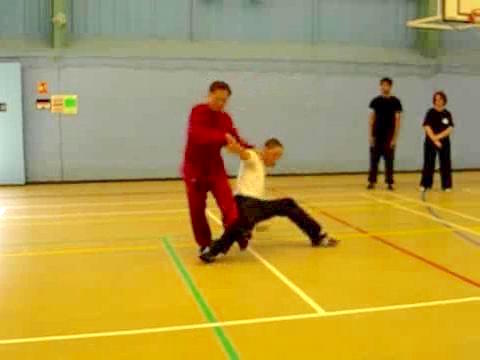
Combat Sequence 11 is short but contains two sophisticated felling techniques, executed with the patterns “Arresting Horse at Cliff” and “Silly Bridegroom Kicks Carriage”. In order to execute the techniques well, one must practice them persistently in solo. Many martial artists seeing the solo practice may not know the felling techniques hidden in it.
Click here to enter.
62 Arresting Horse and Kicking Carriage
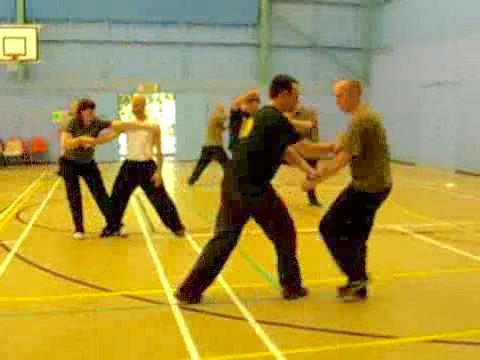
When you move in to fell an opponent, as in “Arrest Horse at Cliff”, it is essential to cover yourself well so that your opponent cannot strike you, a very important precaution many martial artists neglect. The second felling technique, “Silly Bridegroom Kicks Carriage”, is interesting. You fell an opponent when he tries to fell you, and you do so without having to hold or throw him!
Click here to enter.
63 Taming Tiger and Striking Rock
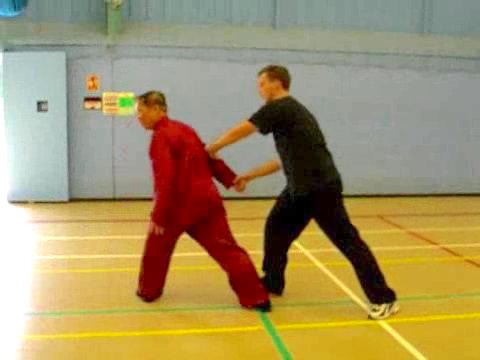
As your opponent attacks with a strike, grip his arm and press him onto the ground, using the pattern “Lohan Tames Tiger”. How would you counter if you are pressed down in this way? A good counter is “Turn Body Strike Rock”. You should grip the opponent's arm with one hand and strike him with the other. If he applies this attack on you, you can get to his back and strike him.
Click here to enter.
64 Solo Practice of Combat Sequences 10, 11 and 12

Today many people practice kungfu merely for demonstration as they have missed the combat application of the kungfu patterns they practice. In this connection, the six sequences shown here, which can be formed into a kungfu set when linked together, are interesting. Can you tell the combat application of the patterns in the sequences? Besides combat application, there are also other functions of solo practice, such as perfecting the form, developing internal force and enhancing fluidity of movement.
Click here to enter.
65 Tantui Patterns in Free Sparring, Especially against Boxing
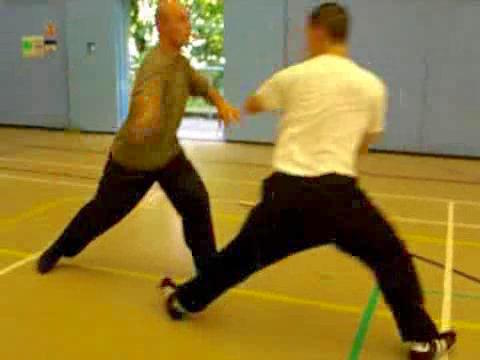
Set practice and combat sequences lead to free sparring. Here, course participants apply patterns from Shaolin Tantui to spar freely and spontaneously. As many martial artists today use Boxing and Kick-Boxing in their free sparring, our course participants spend some time sparring with partners who pose as Boxers. Sparring against Kick-Boxing will be shown in the next video series.
Click here to enter.
66 Questions and Answers, and Handling Kick-Boxing
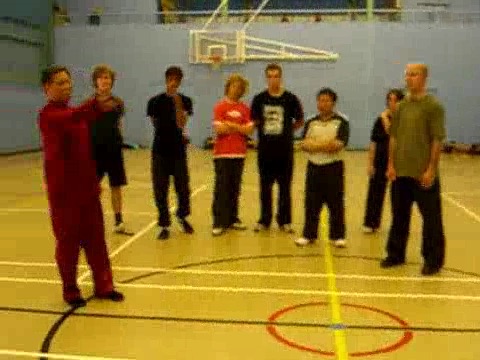
Here are answers to questions form course participants. It is essential to cover an opponent, especially a Boxer, when moving in to attack him. How to move in effectively and how to handle a Kick-Boxer are explained. An excellent way to counter an opponent's kick is to strike his kicking leg.
Click here to enter.
Tantui Course at UK Summer Camp 2007
- 1. The Secret of Internal Force Training
- 2. Experiencing the Effects of Deviated Practice
- 3. Basic Footwork Training
- 4. From Correct Movement to Speed and Elegance
- 5. Various Ways of Turning
- 6. Adding Hand Forms to Stances to Form Patterns
- 7. The Mechanics of "Fa-Jin" or Explode Force
- 8. "Bo-Fa" and "Shen-Fa" or Footwork and Body-Movement
- 9. The Three Harmonies of Legs, Body and Hands
- 10. Tantui Sequence 1 -- Thrust Punch
- 11. The Three Fs -- Form, Force and Flow
- 12. Every Kungfu Session is a Training of Energy and Mind
- 13. Simple in Appearance but Profound in Application
- 14. If you Use a lot of Kicks, you should also Know their Counters
- 15. It is Necesary to have an Element of Threat in Combat
- 16. Counters against Formidable Muay Thai Knee Jabs
- 17. Against Shoots, Against Throws, and Felling Opponents
- 18. Learning Tantui Sequences 1, 2 and 3
- 19. Learning Tantui Sequences 4, 5 and 6
- 20. Learning Tantui Sequences 7, 8 and 9
- 21. Learning Tantui Sequences 10, 11 and 12
- 22. Applications of Single Spread and Breaking Lock
- 23. Breaking Almost any Lock with the Breaking Lock Technique
- 24. The Richness of Tantui Combat Applications
- 25. Second Brother and White Horse
- 26. An Effective Sequence against Boxers
- 27. Three Harmonies in Tantui Combat Sequence One
- 28. White Horse Returns Head
- 29. Adjustments and Modifications in Varied Situations
- 30. Effective Techniques against Boxers
- 31. Combat Skills against Boxers
- 32. The Tactics of Covering and Chasing against Boxers
- 33. The Unbelievable Effectiveness of Tantui Combat Sequence One
- 34. Old Elephant Drops Tusk in Tantui Combat Sequence Two
- 35. Rising Dragon Galloping Tiger
- 36. Combining Sequences in Combat Training
- 37. Importance of Skills in Applying Combat Sequences
- 38. Some Effective Skills for Combat
- 39. Three Rings Around Moon in Tantui Combat Sequence Three
- 40. Applying Chin-Na and Countering Chin-Na
- 41. Solo Performance to Enhance Combat Efficiency
- 42. Simple in Solo Performance, Profound in Combat Application
- 43. Counter against the Formidable Muay Thai Knee Jab
- 44. Felling an Opponent without Throwing Him
- 45. Tantui Combat Sequences One, Two and Three
- 46. Chopping Firewood and Hook Thrust
-
47. The Technique of Double Spread in the Pattern Carry Moon in Bosom
-
48. Combat Sequences 4, 5 and 6 in Solo Practice and Partner Combination
-
49. Sounding Bell to Handle Fast, Continuous Strikes
- 50. Using a Nail Kick to Counter a Whirlwind Kick
-
51. Cloud Hand and Horn Punch against Chin-Na and Throat Strike
-
52. A Little Jump as a Trick
-
53. Striking Opponent Before he Realizes with Shooting Spear
-
54 Technique to Counter Chin-Na or Gripping Attacks
-
55. Hand Technique to Counter Hand Attacks and Leg Technique to Counter Low Kicks
-
56. Amazing Combat Functions in Combat Sequences 7, 8 and 9
-
57. Countering any Attacks and Tempting an Opponent into a Trap
-
58. Continuous Attacks of Combat Sequence 10
-
59. Pressing Attacks with Continuous Spring-Kicks
-
60. Picture-Perfect Form in Planned Sequence of Pressing Attacks
-
61. Two Sophisticated Felling Techniques in Combat Sequence 11
-
62. Arresting Horse and Kicking Carriage
-
63. Taming Tiger and Striking Rock
-
64. Solo Practice of Combat Sequences 10, 11 and 12
-
65. Tantui Patterns in Free Sparring, especially against Boxing
-
66. Questions and Answers, and Handling Kick-Boxing
